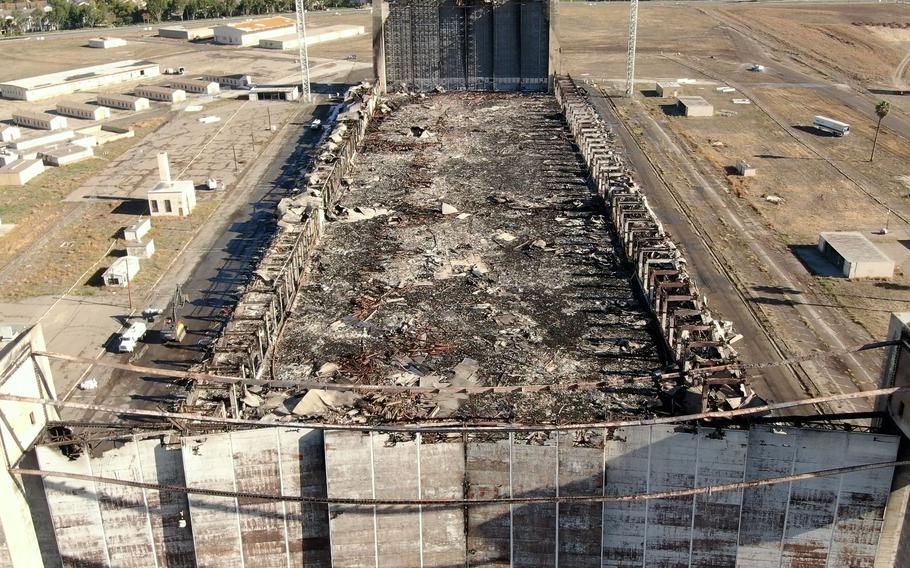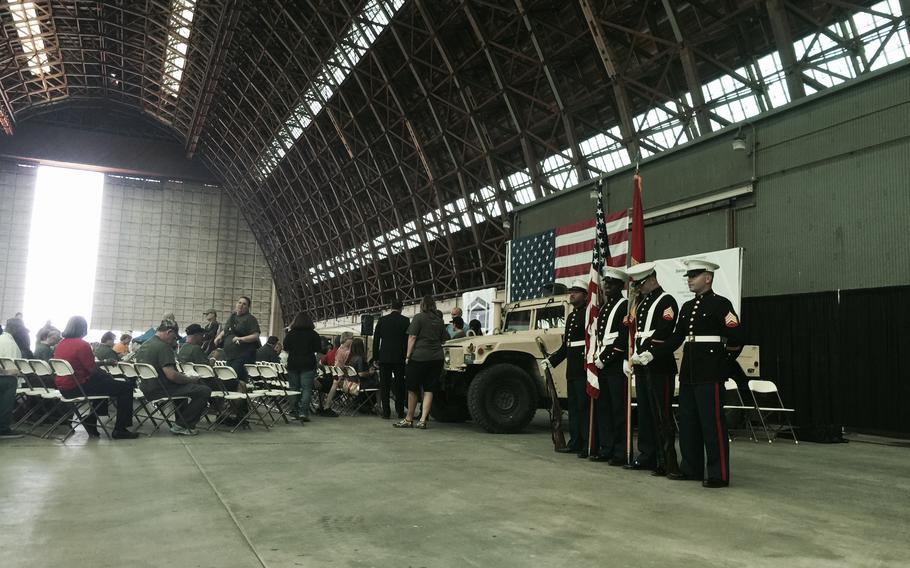
The ruins of the North Hangar at the former Marine Corps Air Station Tustin soon after the Nov. 7 fire. The metal doors have since been lowered to the ground, but the concrete pillars still stand. (City of Tustin)
The Navy could pay up to $137 million to clean up the site of a World War II blimp hangar in Southern California destroyed in a fire in November, local officials estimate.
What started as a Navy commitment of $1 million to allow the nearby city of Tustin to begin work on cleanup and remediation has been amended four times in the five months since the fire to reach $61 million.
But Tustin officials have said the city has spent $90 million — the equivalent of a year’s municipal budget. A resolution in the California legislature put the local spending at $100 million.
Christopher Dunne, spokesman for the Naval Facilities Engineering Command in Washington, D.C., said the Navy knows it is not done paying to abate the damage from the hangar fire at the Marine Corps Air Station Tustin, which closed in 1999. It is working on another amendment to commit more money for the city.
“The Navy fully supports the city’s hangar fire response efforts — within the limits of its authorities and responsibilities,” he said.
Tustin Mayor Austin Lumbard said city analysts believe what the Navy will owe Tustin and what the service will spend directly on carting away the debris and tearing down the remaining pieces of the structure will push the total price tag to more than $137 million.
“And that is just for now — it doesn’t count any problems we find later on,” he said.
The U.S. Environmental Protection Agency ruled soon after the fire that the Navy was responsible for the damages from the fire and toxic emissions. The key reason was the North Hangar that burned was one of two World War II-era, anti-submarine blimp sheds built with 1 million board feet of Douglas fir. The Navy built them in 1942 and still owns the sites.
The hangars were a rare holdover of the days when the military operated several bases throughout Southern California in the early days following the Japanese attack on Pearl Harbor.
The hangars were obsolete by the end of World War II but remained icons on the landscape, even as the population of Orange County ballooned from 200,000 in 1950 to 2.8 million by 2000.

The South Hangar at the former Marine Corps Air Station Tustin was used for local events, such as this 2015 Veterans Day commemoration. (U.S. Marine Corps)
The Tustin base closed as part of the post-Cold War cutbacks on domestic military installations. The 5,000 Marines and their CH-53E Super Stallions, CH-46 Sea Knights and C-130 Hercules moved a few dozen miles south to Marine Corps Air Station Miramar, Camp Pendleton and Naval Air Station North Island — all in San Diego County.
The Navy conveyed 1,300 acres of the 1,600-acre Tustin base to the local government to be used for parks, schools, homes, businesses and other civic uses.
But the Navy held on to the oldest part of the base — the two 17-story blimp hangars. They were on the National Register of Historic Places, and the Navy wanted to make certain that it had a say in how the structures would be used in the future. Plans came and went — museums, a waterpark and repair shops for a new wave of lighter airships.
Though the Marines had been gone for nearly 25 years, the hangars remained Navy property at the end of 2023 when the North Hangar caught fire on Nov. 7, burned for a week and smoldered for 24 days.
The agreement with the Navy allowed Tustin to sign contracts and hire workers to clean up the area around the hangar. However, as the amounts increased, Tustin officials worried the gap between costs and reimbursements would wreak havoc on the city’s ability to pay for police, fire, schools and other services.
With California facing a $45 billion budget deficit, Gov. Gavin Newsom slammed the door on state help early, saying the problem was one for the Navy and local government to solve.
Dunne said the Navy has no specific cutoff point for monetary aid to Tustin. However, the funds for the Tustin base are dispersed through the Navy’s Base Realignment and Closure Program Management Office, which handles 28 Navy and Marine Corps properties from Alaska to Puerto Rico and Maine to Southern California.
“Sometimes the wheels of government turn slowly,” Dunne said.
Orange County’s congressional delegation has called for supplemental funding from the Pentagon that could go more directly to Tustin than through the BRAC process.
“In my meetings with the Navy, I have made it clear that delays to this process are unacceptable,” said Rep. Young Kim, R-Calif., whose district includes the hangar fire site.
However, no additional federal dollars have been set aside yet in the 2025 National Defense Authorization Act, an annual must-pass bill that sets priorities for the Pentagon now being drafted by Congress.
The Navy also has worked to remove debris and take down the four concrete pillars that once held the massive metal doors of the North Hangar. Soon after the fire, the Navy signed a $6 million contract with ECC Environmental to handle the final deconstruction. However, the plan has had to snake through federal and state environmental, air quality and health care agencies, and local governments.
“Field work is expected to begin this summer,” Dunne said.
Until then, the ruin of the 1,000-foot-long hangar sits like a long scar across the city, with a tarp spread over the debris. Lumbard, the Tustin mayor, laments that for the approximately 90,000 veterans living in Orange County, it’s a sad reminder of what was once a proud symbol of the area’s military role.
“Six months later and it still looks like a disaster area,” he said.